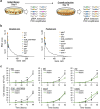CRISPR/Cas9-based genome-wide screening of Dictyostelium
- PMID: 35780186
- PMCID: PMC9250498
- DOI: 10.1038/s41598-022-15500-3
CRISPR/Cas9-based genome-wide screening of Dictyostelium
Abstract
Genome-wide screening is powerful method used to identify genes and pathways associated with a phenotype of interest. The simple eukaryote Dictyostelium discoideum has a unique life cycle and is often used as a crucial research model for a wide range of biological processes and rare metabolites. To address the inadequacies of conventional genetic screening approaches, we developed a highly efficient CRISPR/Cas9-based genome-wide screening system for Dictyostelium. A genome-wide library of 27,405 gRNAs and a kinase library of 4,582 gRNAs were compiled and mutant pools were generated. The resulting mutants were screened for defects in cell growth and more than 10 candidate genes were identified. Six of these were validated and five recreated mutants presented with growth abnormalities. Finally, the genes implicated in developmental defects were screened to identify the unknown genes associated with a phenotype of interest. These findings demonstrate the potential of the CRISPR/Cas9 system as an efficient genome-wide screening method.
© 2022. The Author(s).
Conflict of interest statement
The authors declare no competing interests.
Figures





References
Publication types
MeSH terms
Substances
LinkOut - more resources
Full Text Sources
Research Materials

